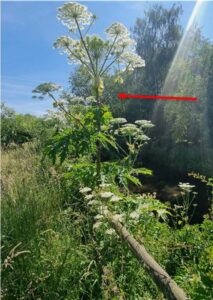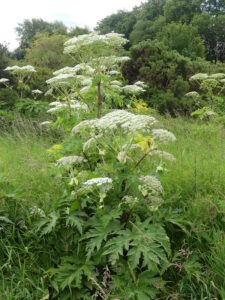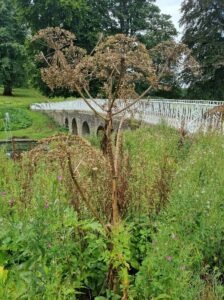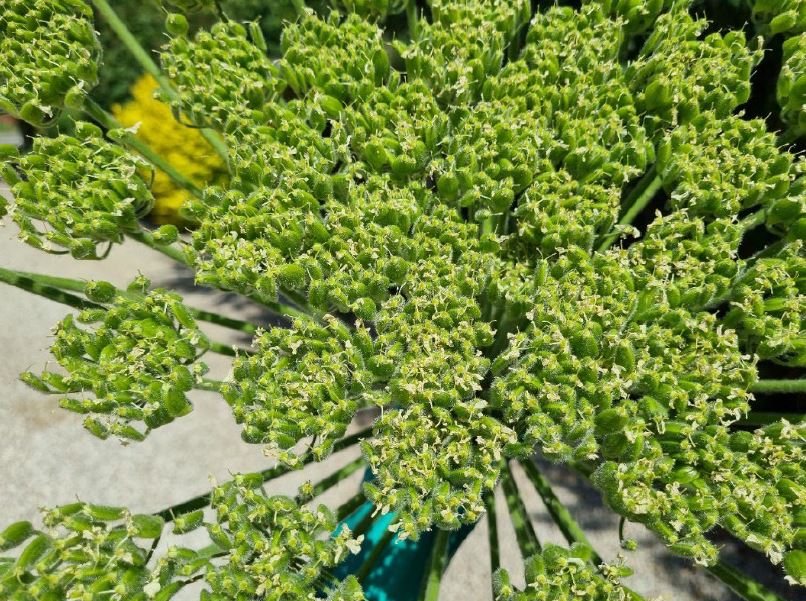Contents
- Understanding Giant Hogweed
- The Impact of Giant Hogweed in the UK
- Identifying Giant Hogweed
- Safety Precautions When Dealing with Giant Hogweed
- Step-by-Step Guide to Control Giant Hogweed
- Preventing Future Giant Hogweed Growth
- Conclusion
Understanding Giant Hogweed
Giant Hogweed (Heracleum mantegazzianum) is a non-native, invasive plant species that originated from the Caucasus Mountain region between Eastern Europe and Western Asia. It was introduced to the UK in the 19th century as an ornamental and architectural plant due to its impressive size and striking appearance. However, its rapid growth and aggressive spread soon led to its classification as a harmful invasive species. This towering plant, capable of reaching heights of up to 5 metres, poses serious threats to both human health and local biodiversity.
Giant Hogweed is a member of the Apiaceae family, which also includes carrots, parsley, and celery. It is a biennial or perennial plant, meaning it takes two years to complete its life cycle or can live for several years. In its first year, Giant Hogweed grows as a rosette of leaves close to the ground. In its second year, it produces a tall, hollow stem with large, deeply lobed leaves and umbrella-shaped white flower clusters.
The Impact of Giant Hogweed in the UK
The introduction of Giant Hogweed to the UK has had significant environmental and health impacts. Its rapid growth and aggressive spread allow it to outcompete native plant species for resources such as light, water, and nutrients. This can lead to a decrease in biodiversity and disrupt local ecosystems.
Moreover, Giant Hogweed poses a serious health risk to humans. The plant’s sap contains a toxic compound called furanocoumarin, which can cause a condition known as phytophotodermatitis. When the sap comes into contact with skin and is exposed to sunlight, it can cause severe skin irritations, blisters, and burns. These reactions can occur within 15 minutes of exposure and may last for several months.
Furthermore, Giant Hogweed can also impact land use and property values. Its presence can make areas unsafe for recreational activities and reduce the aesthetic appeal of gardens and parks. The cost of controlling and removing Giant Hogweed can also be substantial, placing a financial burden on landowners and local authorities.
In response to these impacts, it is crucial for UK residents to understand the importance of controlling Giant Hogweed and take necessary actions to prevent its spread.
Identifying Giant Hogweed






Before you can control Giant Hogweed, it’s crucial to identify it correctly. Look for large, umbrella-shaped white flower clusters, purple-spotted stems, and deeply lobed leaves that can reach up to 1.5 metres in width. Here’s a seasonal guide to help you identify this invasive species throughout the year:
- Spring: In early spring, Giant Hogweed emerges as a rosette of deeply lobed, dark green leaves. These leaves can be up to 1.5 metres in width and have a shiny, waxy appearance. The stems are purple-spotted and covered in coarse white hairs.
- Summer: As summer approaches, the plant begins to bolt, producing a tall, hollow stem that can reach up to 5 metres in height. The stem is stout and rigid, with purple blotches and bristly hairs. In late summer, the plant produces large, umbrella-shaped white flower clusters that can be up to 80 cm in width.
- Autumn: After flowering, the plant produces numerous green, ribbed seeds that turn brown as they mature. These seeds are held in flattened clusters that can be up to 15 cm in width. The plant begins to die back in late autumn, leaving behind a hollow stem and a large rosette of leaves.
- Winter: In winter, Giant Hogweed dies back almost entirely, leaving only a large, fleshy taproot in the ground. This taproot can be up to 50 cm long and 8 cm in diameter. It is cream-coloured with a brown, corky exterior.
Giant Hogweed can be easily confused with other, less harmful plants, such as Cow Parsley and Hogweed. If you’re unsure about the identification, it’s best to seek advice from a professional or your local council before taking any action.
Safety Precautions When Dealing with Giant Hogweed
When dealing with Giant Hogweed, safety is paramount. Always wear protective clothing, including gloves, long-sleeved shirts, and trousers. Avoid contact with the plant’s sap and wash thoroughly if any contact occurs.
Step-by-Step Guide to Control Giant Hogweed
Controlling Giant Hogweed can be a challenging and potentially hazardous task, often best left to professionals. Here’s a step-by-step guide emphasising the use of professional services and noting the potential adverse effects of chemical control methods.
Identify the Problem
Correctly identify Giant Hogweed on your property. If you’re unsure, consult with a professional who can confirm the identification.
Assess the Situation
Determine the extent of the infestation. For large or widespread infestations, it’s highly recommended to seek professional assistance.
Hire a Professional
Look for a reputable, licensed contractor experienced in controlling invasive species. They will have the necessary equipment, knowledge, and safety measures to effectively and safely manage Giant Hogweed.
Chemical Control Methods
While herbicides can be effective, they should be used with caution due to their potential environmental impacts. Herbicides can harm non-target species and contaminate water bodies if not used correctly. Therefore, it’s best to have a professional apply these chemicals.
Non-Chemical Control Methods
These methods, such as cutting or digging out the plant, can be labour-intensive and must be done carefully to prevent regrowth. Always dispose of plant parts responsibly to prevent further spread.
Monitor and Follow-up
Regularly monitor the treated area for signs of regrowth. If Giant Hogweed reappears, contact your professional service to discuss further treatment options.
Educate Others
Share your experiences and knowledge about Giant Hogweed with your community. Education is a powerful tool in preventing the spread of this invasive species.
Preventing Future Giant Hogweed Growth
Preventing the spread and future growth of Giant Hogweed is as important as controlling existing infestations. Here are some expanded steps to help ensure this invasive species doesn’t return to your property:
Regular Monitoring
Regularly inspect your property, especially areas prone to Giant Hogweed growth such as riverbanks, ditches, and waste grounds. Early detection can make control efforts easier and more effective.
Proper Disposal
If you’ve removed Giant Hogweed from your property, ensure all plant parts are disposed of properly. Do not compost these parts as they can still produce viable seeds. Instead, seal them in heavy-duty plastic bags and send them to a landfill or incinerate them where local regulations permit.
Avoid Seed Spread
Giant Hogweed produces a large number of seeds that can remain viable in the soil for several years. Avoid activities that can disturb the soil and bring these seeds to the surface, such as digging or tilling.
Maintain Healthy Ecosystems
A healthy, diverse ecosystem is more resistant to invasive species. Encourage the growth of native plant species to outcompete any potential Giant Hogweed seedlings.
Control Waterways
Giant Hogweed often spreads through waterways. If you live near a river or stream, consider installing barriers to prevent the movement of seeds downstream.
Educate Others
Share your knowledge about Giant Hogweed with your community. Teach them how to identify the plant, the dangers it poses, and how to prevent its spread.
Report Sightings
If you spot Giant Hogweed in a new area, report it to your local council or invasive species management agency. Early detection and reporting can prevent new infestations from becoming established.
- PlantTracker: This is a citizen science project where you can report sightings of various invasive plant species, including Giant Hogweed. You can submit your findings through their website or mobile app. Website: PlantTracker
- The Non-Native Species Secretariat (NNSS): The NNSS is a UK government initiative that provides a reporting system for invasive species. You can report Giant Hogweed sightings through their online reporting form. Website: NNSS Reporting Form
- Your Local Council: Many local councils in the UK have their own systems for reporting invasive species. You can usually find this information on your council’s website. If you’re unsure who your local council is, you can find out using the following link: Website: Find your local council
- The Wildlife Trusts: Some local Wildlife Trusts also accept reports of invasive species. You can find your local Wildlife Trust using the following link: Website: Find your local Wildlife Trust
By following these steps, you can significantly reduce the risk of future Giant Hogweed growth on your property and in your community.
Conclusion
Controlling Giant Hogweed is a responsibility shared by all UK residents. By understanding this invasive species, taking necessary safety precautions, and following effective control methods, we can protect our local biodiversity and ensure the safety of our communities.
The Postcode Areas We Serve
Gloucester and Swindon
Birmingham and the Midlands
Bristol and the South West
Cardiff and South Wales










